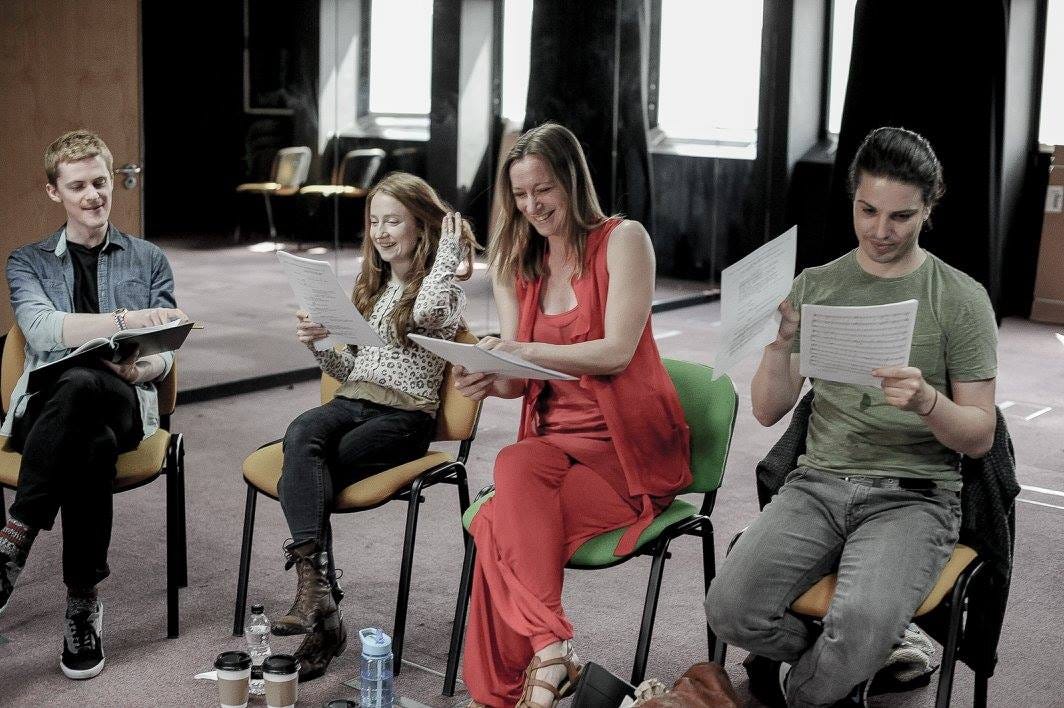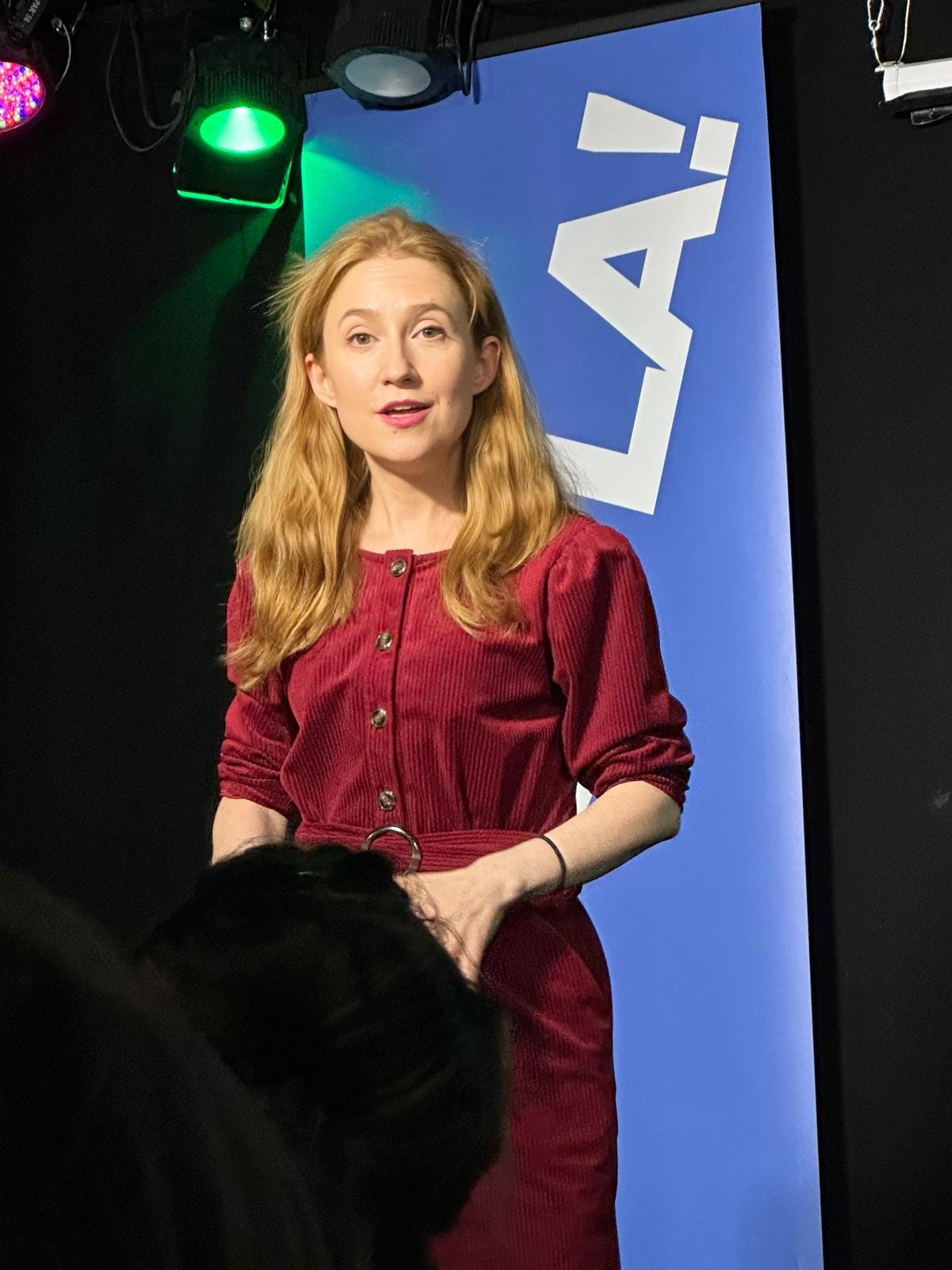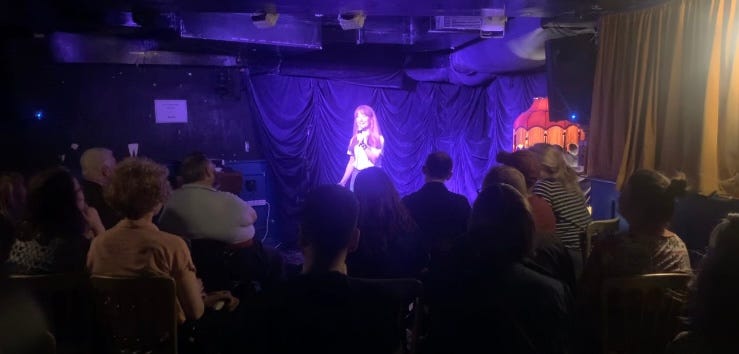Last week I performed in Showstopper! The Improvised Musical at The Edinburgh Fringe for a week (which was lovely) and then came home to do my work in progress shows at The Camden Fringe. It was a bit of a strange idea in retrospect, being in one Fringe festival while trying to plug the other. As always, the thing that was most stressful was not the writing/performing but the endless self promotion. I used to think my dream was to get to a position in my career where I wouldn’t have to get changed in a cold public toilet, but now I think the dream is for someone else to do the marketing. What heaven that would be!!
Anyway…
This is a solo show which I’ve been gently building for a little while, trying out a couple of the characters at various nights, and writing/thinking about the other characters and moments. I’d been doing most of this work on my own, but, as it got nearer, the loneliness of not having anyone to collaborate with was driving me insane. Sometimes I would literally sit by my laptop and say out loud “WHAT IS FUNNY?”
I come from a theatre background originally, and as such I am used to collaboration. I love being in a rehearsal room with multiple people, building something as a team and watching as each department’s contributions add to the whole. When working on a scripted play I enjoy getting notes from the director, and having different things to focus on for the next run-through or performance. This is what theatre is: lots of people making one thing together. Nowadays I hear solo comedy performers talking about their (sometimes quite extensive) team of people too, but when I was younger I didn’t think that was an option in comedy! Also, financially at the time it literally wasn’t.

This time around I managed to have a little bit of collaboration. I had just about learnt how to use QLab, and had made a couple of very basic tracks for the show on Garageband myself, but I got a bit stuck with the more conceptual/longer sound-cue bits, so Benjamin Partridge (of the brilliant Beef and Dairy Podcast) helped me with those, making my Robot and phone sections sound strange and excellent. The rest of the sound I muddled through with on my own, and if you were in the audience and listened carefully you could hear the awkward join in the Garageband loop when I was improvising. This is why sound designers exist in theatre!
By mid-August it got to the point where I realised I needed some directorial help too, albeit in a very last minute way. So I had a day in a room with an excellent director called Katharine Armitage who whipped my WIP into shape, helping me find transitions between the disparate bits, and getting it ready for an audience. We also workshopped a couple of characters (who were initially just thoughts) so that I could try them out. I improvised them (with some steers from Katharine) and we noticed what did/didn’t work from those improvisations. We called these characters “One Minute Men” because I was only going to perform them briefly in the show. Working with Katharine was great. At the start of the day she asked me what I wanted to get out of the work in progress shows and I said I wanted to experiment, try out new characters and find out “how weird is too weird for the audience”. It was really useful saying these things out loud because then I had to stick to them - and I did!
I tried out new characters (many of whom had not been put in front of an audience ever), experimented, and found out what was too weird for the audience. Funnily enough the woman who swallowed a well (you had to be there) is not too weird for audiences. Another section was too weird for some, but I think that’s more about me making a complicated concept, clearer and shorter. I also wanted to experiment with a crowd bit, which Katharine encouraged me to try and (thankfully!) people were on board with that too. I might not have tried it had she not encouraged me to do so.
When doing a solo comedy show with lots of sound cues it’s essential to have someone on tech who knows what they’re doing and fortunately I managed to rope a great technician on board Jules Miller-Bakewell at the last minute, who had teched my shows before, and therefore wasn’t thrown by the fact that numerous moments were audience dependent/improvised. We didn’t quite have time to go through the whole show in our allotted hour of tech time sadly. One hour is not long is it? This is why theatre has DSM’s (Deputy Stage Managers) for the entire rehearsal process. Despite the lack of time, Jules was brilliant as always and we were both pleased with how it went cue-wise.
I did three shows in total and the audiences were lovely (and slightly different) in all three. I’m a geek when it comes to audiences. It’s fascinating how a group of people who don’t know each other will become, for example, “A Thoughtful Audience” “A Loud Audience” “A Shy Audience who become really on board” etc etc. Sometimes the reason for group mood might be down to the performer or show. At other times it can be influenced by all kinds of things; whether audience members are mainly there for fun/obligation, whether people are there in groups/on their own, whether the lighting makes people feel exposed, whether the pre-show music is too depressing, whether there’s a massive gap between the main bank of seating and some seats right at the back…. There are so many factors! If I could do a PHD on audiences I would. I absolutely love them. In the pandemic I literally felt homesick for audiences which I’m aware is extremely odd, but for me, (consensual) interaction with audiences has become one of my favourite things to explore as a performer.
The first of my work in progress shows was at The Bill Murray and it was such a positive experience. It’s clear that this is a venue which is run by people who love and understand comedy and as a result it’s a brilliant venue to perform at. We had a lot of fun at The Bill Murray (one of my “one minute men” characters even got heckled which was enjoyable!) and I got nice feedback from strangers who had found it funny and enjoyed the variety. Phew! The following two performances took place at Aces and Eights and again there were lovely audiences (very different each time) and lots of fun interactions.
One unexpected bonus of the Aces and Eights shows was having my friend Claire Lamont (who had driven down from Scotland to be there) at both, and hearing her thoughts. Claire is an amazing Actress, Director, Writer and Theatre-Maker. Over the years we have had the opportunity to show each other what we’re working on now and again. So it was a treat to have her watch the first Aces and Eights performance and give me (solicited!) insights and notes for the following one.
Both fringe festivals have ended now, and I can breathe a sigh of relief. It’s nice knowing I don’t have to check sales figures every day, especially because with regards to one venue I didn’t realise I could only see half the sales (the other half was through their own system) and was panicking unnecessarily. It was stressful AND tedious - what a combination!
Next I want to make changes, keep trying stuff and keep playing with audiences. I don’t know where the show will go ultimately, but this work in progress has shown me that I want it to go somewhere. I’m excited to build it and (hopefully) to build it with other people.





So true about the communal aspect of making a new theatre work. I find it so strange that people still (mostly) write plays alone in their study and then hand it over to a director, as if the writing were suddenly somehow complete. For me, when you can find that balance between the loneliness of writing and the chaos of devising with a bunch of people, that's where the magic is.